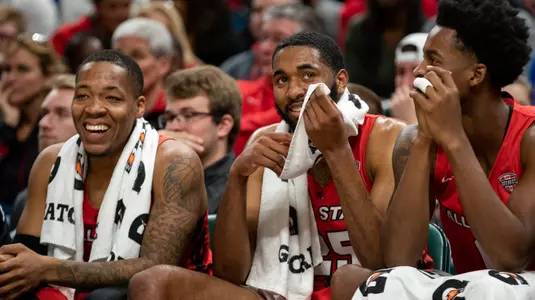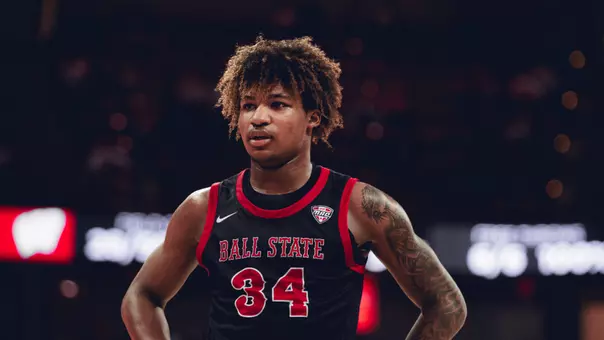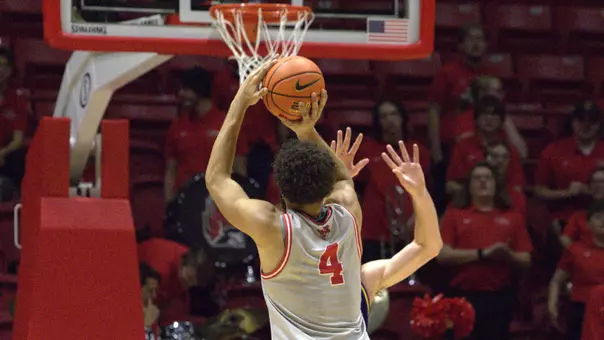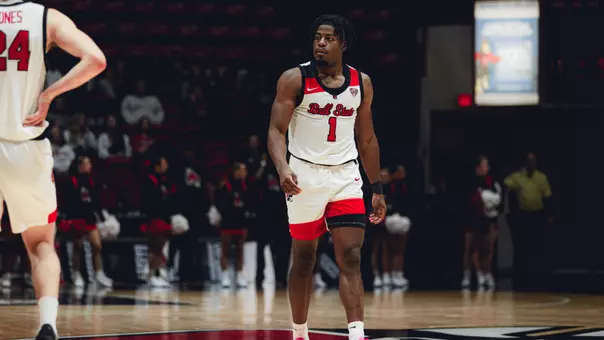Ball State University Athletics

Photo by: Kyle Crawford
Focusing on What Was, Not What If: BSU Men’s Hoops in 2019-20
April 10, 2020 | Men's Basketball
In a season cut short at its height, the Cardinals still had plenty to celebrate
The Ball State men's basketball season ended with so many "what if's."
Hopes were high that Thursday in Cleveland. BSU had won four of its last five games, smashed Northern Illinois on the road in the regular season finale to earn a share of another MAC West Division championship and entered the MAC Tournament seeded third.
The Cardinals had gone through their morning shootaround at Rocket Mortgage FieldHouse and were nine hours from tipping off in the quarterfinals against Kent State. That's when everything came to a screeching halt.
With concerns about the spread of COVID-19 growing by the hour, and with leagues around the country doing the same, the tournament was canceled before it began. Just like that, the season was over.
Ball State was left to wonder what might have been. The Cardinals were two wins shy of reaching 20. They would almost certainly have appeared in one of the postseason tournaments. And they had perhaps their best chance in recent memory of winning a conference championship and breaking down the door into the NCAA tournament.
But more than for the "what if's," the 2019-20 season should be remembered for what was. It was a group coming together to play as one and win its division. It was a key player realizing his potential as one of the best in the MAC. And it was a unit that formed into one of the historically great defenses in the Mid-American Conference.
It was a season of great atmospheres and lots of wins inside Worthen Arena, of youth emerging and of promise for the future. In a season that ultimately lacked the chance to play for the greatest prize, Ball State was not short on accomplishments.
A Together Team
There may have been some questions on the outside coming into the season as to what this team would look like. All-MAC players Tayler Persons and Trey Moses had graduated and moved on to professional careers. When K.J. Walton went down with an ankle injury during non-conference play, another veteran presence on the floor was gone. That left Tahjai Teague and Kyle Mallers as the only returning starters.
But this team just had something about it, a nice balance to it. The Cardinals enjoyed playing for one another. It was a group head coach James Whitford often referred to as a "together team." BSU ranked second in the MAC in assist percentage. The Cardinals had 10 different players score double figures in a game and four reach the 20-point mark at least once. Teague became a dominant player (more on that later), Ishmael El-Amin emerged as a real scoring threat, Mallers was his consistent self every night, and young guys like Jarron Coleman and Luke Bumbalough filled key roles (more on that later, too).

Tahj Takes the Mantle
Teague had always been a good player and one of Ball State's key pieces throughout his career. He had racked up more than 1,000 points and nearly 700 rebounds through his first three seasons. He had always done everything well. This year, though, he did everything exceptionally. The Indianapolis product became an absolute force on his way to All-MAC First Team and MAC All-Defensive Team honors. He was BSU's first recipient of first-team recognition in nearly a decade, and Ken Pomeroy's metrics rated him as the MAC's top player, ahead of league player of the year Loren Cristian Jackson of Akron.
Teague, who averaged a double-double throughout the majority of the conference schedule, finished the full season with career-high marks of 14.4 points and 9.1 rebounds per game. He led BSU in both of those categories, plus blocks, steals and field goal percentage. To fully cement his legacy as an all-around great, Teague finished his career as the only player school history whose career numbers rank among the top 10 in each of those five categories. He was named the MAC West Division Player of the Week a school-record six times on the year, and his ability to guard every position on the floor played a big role in Ball State's defensive prowess.

Historically Great Defense
Now about that defense. Statistically, no team in the MAC has been better on that end of the floor since at least the 2001-02 season. That's as far back as Ken Pomeroy's metrics go. Ball State allowed an average of 94.0 points per 100 possessions. That wasn't just the best number in the MAC this year; it was tied with Western Michigan's 2002-03 team for the league's best mark over the past 19 years.
During conference play, Ball State ranked first in the MAC in scoring defense (63.5), field goal percentage defense (.402) and 3-point percentage defense (.291). The Cardinals held conference opponents to fewer than 60 points seven times and forced league foes into less than 30 percent shooting from beyond the arc 10 times (in 18 games). For the full season, BSU's scoring defense (62.5) ranked 17th in the country.
The Cardinals were perhaps at their defensive best in their two meetings with Northern Illinois and one of the league's top offensive players Eugene German. BSU held the All-MAC first teamer to a combined 29 percent shooting (12-of-41) and 17 percent from 3-point range (3-of-18) on the way to two critical victories.

Protecting Home Court
Ball State's home court record of 11-4 for the full season was good but not otherworldly. In fact, the Cardinals were only 3-3 at Worthen Arena during the non-conference portion of the schedule. But something flipped when the new year hit. The Cardinals opened MAC play with back-to-back wins over expected contenders Toledo and Buffalo and never looked back.
BSU lost just one home game the rest of the way (against a Bowling Green squad that was leading the league at the time) en route to an 8-1 mark at Worthen in conference play. It was the program's best home league record since 2002. The eight wins came by an average of 10.3 points, highlighted by the 20-point rout of defending champion Buffalo in early January.
And the home court success was certainly aided by continuously increasing crowds inside Worthen Arena. Ball State led the league in attendance for the first time since 2005-06, averaging 4,439 fans per game. A season-high 5,921 were on hand to witness a win over Eastern Michigan in the fifth-annual #MuncieOut game.

Emergent Youth
Ball State knew coming into the season it was going to have to rely on some freshmen; it just may not have known exactly how heavily. In fact, once league play hit, the Cardinals relied on more minutes from rookies than any team in the MAC.
Coleman's playmaking ability allowed him to emerge as the starting point guard early in the season, and Bumbalough jumped into the starting lineup when Walton went down with his ankle injury. That duo started at the No. 1 and 2 guard spots the rest of the way. Coleman went on to be named the MAC Freshman of the Year, leading all league rookies in scoring, rebounds and assists during conference play. Bumbalough was the top MAC freshman in minutes played during the conference season and in made 3-pointers for the year.
By the time league play started, Kani Acree had come along to become a third BSU freshman seeing significant minutes. He played in the final 17 games, developed into one of the Cardinals' first players off the bench and played his best basketball down the stretch.

Promise for the Future
The Cardinals will no doubt have to deal with the losses of Teague, Mallers, El-Amin and Josh Thompson. They will all leave different shoes to fill. But the play of the roster's underclassmen this season provides optimism that BSU is in position to contend again next year.
It is exciting to think about what the tandem of Coleman and Bumbalough can become in the years ahead together. And key players like Acree, Brachen Hazen and Miryne Thomas are all capable of making significant contributions. Thomas' breakout performance over the final weeks of the season was certainly something to build on.
Add to that the potential that lies with big men Blake Huggins and Ben Hendriks. And the fact the Cardinals will have Zach Gunn back from injury and are seeking a sixth-year of eligibility for Walton. And the ability to add more pieces starting next week when high school seniors and potential transfers are once again able to sign. The full picture shows a program that is ready to aim high again in 2020-21.
Hopes were high that Thursday in Cleveland. BSU had won four of its last five games, smashed Northern Illinois on the road in the regular season finale to earn a share of another MAC West Division championship and entered the MAC Tournament seeded third.
The Cardinals had gone through their morning shootaround at Rocket Mortgage FieldHouse and were nine hours from tipping off in the quarterfinals against Kent State. That's when everything came to a screeching halt.
With concerns about the spread of COVID-19 growing by the hour, and with leagues around the country doing the same, the tournament was canceled before it began. Just like that, the season was over.
Ball State was left to wonder what might have been. The Cardinals were two wins shy of reaching 20. They would almost certainly have appeared in one of the postseason tournaments. And they had perhaps their best chance in recent memory of winning a conference championship and breaking down the door into the NCAA tournament.
But more than for the "what if's," the 2019-20 season should be remembered for what was. It was a group coming together to play as one and win its division. It was a key player realizing his potential as one of the best in the MAC. And it was a unit that formed into one of the historically great defenses in the Mid-American Conference.
It was a season of great atmospheres and lots of wins inside Worthen Arena, of youth emerging and of promise for the future. In a season that ultimately lacked the chance to play for the greatest prize, Ball State was not short on accomplishments.
A Together Team
There may have been some questions on the outside coming into the season as to what this team would look like. All-MAC players Tayler Persons and Trey Moses had graduated and moved on to professional careers. When K.J. Walton went down with an ankle injury during non-conference play, another veteran presence on the floor was gone. That left Tahjai Teague and Kyle Mallers as the only returning starters.
But this team just had something about it, a nice balance to it. The Cardinals enjoyed playing for one another. It was a group head coach James Whitford often referred to as a "together team." BSU ranked second in the MAC in assist percentage. The Cardinals had 10 different players score double figures in a game and four reach the 20-point mark at least once. Teague became a dominant player (more on that later), Ishmael El-Amin emerged as a real scoring threat, Mallers was his consistent self every night, and young guys like Jarron Coleman and Luke Bumbalough filled key roles (more on that later, too).

Tahj Takes the Mantle
Teague had always been a good player and one of Ball State's key pieces throughout his career. He had racked up more than 1,000 points and nearly 700 rebounds through his first three seasons. He had always done everything well. This year, though, he did everything exceptionally. The Indianapolis product became an absolute force on his way to All-MAC First Team and MAC All-Defensive Team honors. He was BSU's first recipient of first-team recognition in nearly a decade, and Ken Pomeroy's metrics rated him as the MAC's top player, ahead of league player of the year Loren Cristian Jackson of Akron.
Teague, who averaged a double-double throughout the majority of the conference schedule, finished the full season with career-high marks of 14.4 points and 9.1 rebounds per game. He led BSU in both of those categories, plus blocks, steals and field goal percentage. To fully cement his legacy as an all-around great, Teague finished his career as the only player school history whose career numbers rank among the top 10 in each of those five categories. He was named the MAC West Division Player of the Week a school-record six times on the year, and his ability to guard every position on the floor played a big role in Ball State's defensive prowess.

Historically Great Defense
Now about that defense. Statistically, no team in the MAC has been better on that end of the floor since at least the 2001-02 season. That's as far back as Ken Pomeroy's metrics go. Ball State allowed an average of 94.0 points per 100 possessions. That wasn't just the best number in the MAC this year; it was tied with Western Michigan's 2002-03 team for the league's best mark over the past 19 years.
During conference play, Ball State ranked first in the MAC in scoring defense (63.5), field goal percentage defense (.402) and 3-point percentage defense (.291). The Cardinals held conference opponents to fewer than 60 points seven times and forced league foes into less than 30 percent shooting from beyond the arc 10 times (in 18 games). For the full season, BSU's scoring defense (62.5) ranked 17th in the country.
The Cardinals were perhaps at their defensive best in their two meetings with Northern Illinois and one of the league's top offensive players Eugene German. BSU held the All-MAC first teamer to a combined 29 percent shooting (12-of-41) and 17 percent from 3-point range (3-of-18) on the way to two critical victories.

Protecting Home Court
Ball State's home court record of 11-4 for the full season was good but not otherworldly. In fact, the Cardinals were only 3-3 at Worthen Arena during the non-conference portion of the schedule. But something flipped when the new year hit. The Cardinals opened MAC play with back-to-back wins over expected contenders Toledo and Buffalo and never looked back.
BSU lost just one home game the rest of the way (against a Bowling Green squad that was leading the league at the time) en route to an 8-1 mark at Worthen in conference play. It was the program's best home league record since 2002. The eight wins came by an average of 10.3 points, highlighted by the 20-point rout of defending champion Buffalo in early January.
And the home court success was certainly aided by continuously increasing crowds inside Worthen Arena. Ball State led the league in attendance for the first time since 2005-06, averaging 4,439 fans per game. A season-high 5,921 were on hand to witness a win over Eastern Michigan in the fifth-annual #MuncieOut game.

Emergent Youth
Ball State knew coming into the season it was going to have to rely on some freshmen; it just may not have known exactly how heavily. In fact, once league play hit, the Cardinals relied on more minutes from rookies than any team in the MAC.
Coleman's playmaking ability allowed him to emerge as the starting point guard early in the season, and Bumbalough jumped into the starting lineup when Walton went down with his ankle injury. That duo started at the No. 1 and 2 guard spots the rest of the way. Coleman went on to be named the MAC Freshman of the Year, leading all league rookies in scoring, rebounds and assists during conference play. Bumbalough was the top MAC freshman in minutes played during the conference season and in made 3-pointers for the year.
By the time league play started, Kani Acree had come along to become a third BSU freshman seeing significant minutes. He played in the final 17 games, developed into one of the Cardinals' first players off the bench and played his best basketball down the stretch.

Promise for the Future
The Cardinals will no doubt have to deal with the losses of Teague, Mallers, El-Amin and Josh Thompson. They will all leave different shoes to fill. But the play of the roster's underclassmen this season provides optimism that BSU is in position to contend again next year.
It is exciting to think about what the tandem of Coleman and Bumbalough can become in the years ahead together. And key players like Acree, Brachen Hazen and Miryne Thomas are all capable of making significant contributions. Thomas' breakout performance over the final weeks of the season was certainly something to build on.
Add to that the potential that lies with big men Blake Huggins and Ben Hendriks. And the fact the Cardinals will have Zach Gunn back from injury and are seeking a sixth-year of eligibility for Walton. And the ability to add more pieces starting next week when high school seniors and potential transfers are once again able to sign. The full picture shows a program that is ready to aim high again in 2020-21.
Players Mentioned
Men's Basketball // Post Game Press Conference at Campbell
Sunday, December 14
'Twas The Week Before #MACtion
Saturday, December 13
This Week in Ball State Sports Podcast // Guests: Adrian Wheatley and Jeff Mitchell
Thursday, December 11
Men's Basketball // Post Game Press Conference vs South Dakota State
Wednesday, December 10



















